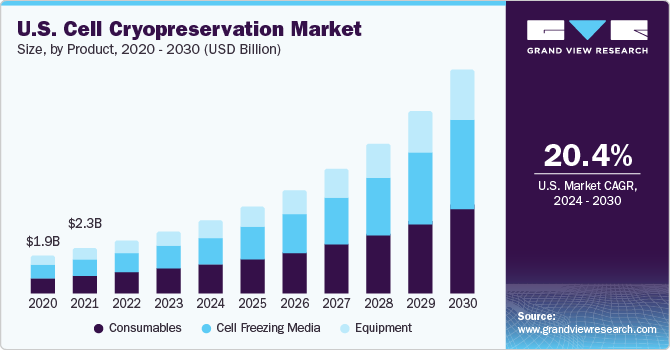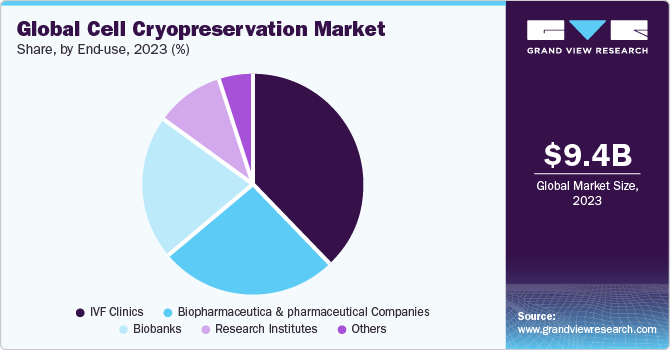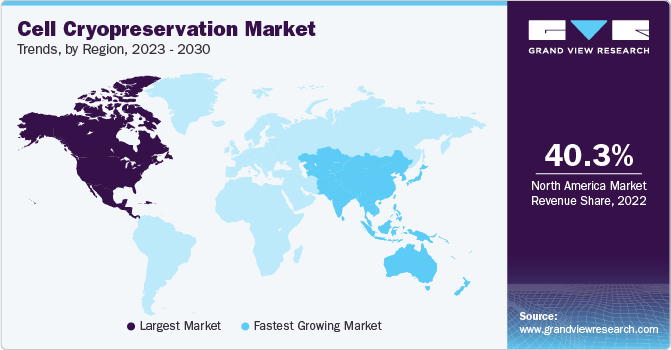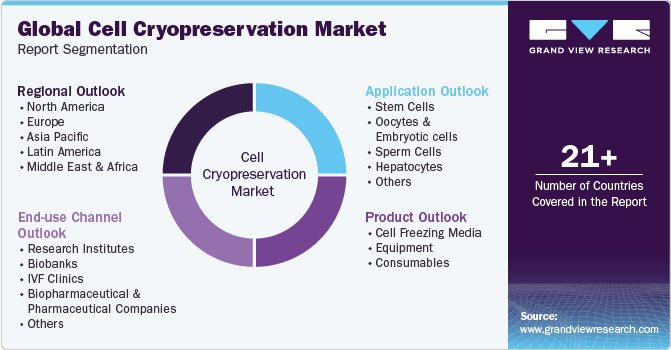- Home
- »
- Biotechnology
- »
-
Cell Cryopreservation Market Size & Share Report, 2030GVR Report cover
![Cell Cryopreservation Market Size, Share & Trends Report]()
Cell Cryopreservation Market Size, Share & Trends Analysis Report By Product (Cell Freezing Media, Equipment), By Application (Stem Cells, Sperm Cells), By End-use (Biobanks, IVF), By Region, And Segment Forecasts, 2024 - 2030
- Report ID: GVR-4-68040-147-0
- Number of Report Pages: 180
- Format: PDF, Horizon Databook
- Historical Range: 2018 - 2022
- Forecast Period: 2023 - 2030
- Industry: Healthcare
Cell Cryopreservation Market Size & Trends
The global cell cryopreservation market size was estimated at USD 9.44 billion in 2023 and is expected to grow at a compound annual growth rate (CAGR) of 21.01% from 2024 to 2030. Cryopreservation is the method of preserving biological material in a suspended condition at cryogenic temperatures for an extended period. It is used to retain the fine structure of cells. For cryopreservation, samples of tissues, cells, organelles, and other biological constructs are cooled to extremely low temperatures, i.e. -80 °C using solid CO2 or -196 °C using liquid nitrogen. Cryopreservation is generally utilized to protect the reproductive capacity of women with breast cancer during the in-vitro fertilization (IVF) cycle before treatment.

COVID-19 had a positive impact on the market. Cryopreservation was critical for vaccine production because numerous steps of processing were needed, including transportation between labs. The requirement for faster turnaround time with efficient solutions from research operations led to the adoption of the ready-to-use freezing medium by a number of research organizations and biopharmaceutical manufacturers. The R&D sector has seen increased investments in terms of collaboration, partnerships, and expansion, propelling market growth. In July 2022, LifeCell International, a producer of human cell, gene, and tissue-based products and services, introduced Cellutions BioStorage, a research-to-launch Cryopreservation Bank. By employing modern technologies, the new organization seeks to bridge the expanding supply-chain gap in biospecimen preservation and maintenance.
Rapid advances in cellular therapy research, as well as the increasing use of cell therapies in a variety of illnesses, have resulted in an increasing demand in the global market. Cell freezing media plays a critical role in preserving cell viability during the thawing & freezing procedures, which is essential for cell therapy applications. Different initiatives implemented by market participants to boost applications of cellular treatments in the management of chronic illnesses are expected to fuel market growth. Scribe Therapeutics and Sanofi established a collaboration in September 2022 to commercialize CRISPR-based cancer medicines, which increased the demand for cryopreservation techniques and further fueled the market growth.
The increased government financing for R&D activities opens up attractive potential for cell cryopreservation expansion. The Indian government has played a critical role in building advanced stem cell research facilities in 40 prominent health research and education institutes. It has pushed stem cell research across several departments and institutes, with national funding organizations such as the ICMR, Department of Biotechnology (DBT), along with the Department of Science and Technology (DST) giving support for both fundamental and practical studies. Thus, it will propel the market growth during the forecast period.
End-use Insights
IVF clinics held 38.07% of the global market share in 2023, accounting for the largest proportion of the market. According to the Society for Assisted Reproductive Technology, 12,438 healthy women froze their eggs in 2020. The number of women who freeze their eggs increased by 72.76% between 2016 and 2020. As more women choose to undergo egg-freezing cycles, there is an increasing demand for dependable and effective cryopreservation methods to ensure the viability of frozen eggs in the long term. This has increased the demand for sophisticated cell cryopreservation technologies & infrastructure, propelling the cell cryopreservation industry forward.

Biobanks are expected to witness the fastest CAGR of 24.06% during the forecast period. Biobanks are critical in the storage and preservation of biological samples, including tissues and cells, for research and clinical applications. According to the National Library of Medicine, economically developed countries had at least 11 biobanks per million people in 2022. Joint efforts help to increase the number of biobanks. Global Biobank Meta-Analysis Initiative (GBMI) was founded by scientists from MIT and Harvard's Broad Institute, as well as collaborators from the University of Michigan and researchers from around the world.Its goal is to simplify the connection of international biobanks, enabling larger and more robust genetic data investigations. This program intends to increase the possibility of detecting novel disease-associated genetic variations by adding more genetic ancestral variety.
Product Insights
Based on product, the consumables segment held 40.76% of the global revenue share in 2023 accounting for the largest proportion of the market. This is primarily due to the factors such as the increasing adoption of cryovials, cryotubes, and other consumables by end-users, due to benefits such as lower contamination. Other factors including the rising prevalence of chronic diseases, growing demand for biologics, and rising demand for cryopreservation among end-users will propel the segment's growth.
The freezing media segment is expected to witness the fastest growth with a CAGR of 23% during the forecast period, due to the widespread use of cryopreservation media in a variety of sectors, including stem cell regeneration, development of drugs, regenerative medicine, and biobanking. However, due to the increased use of equipment in facilities such as biobanks and academic institutes to store and preserve biological material, the equipment sector is predicted to grow at a lucrative rate throughout the forecast period.
Regional Insights
North America accounted for the largest market share of 40.26% in 2023. The availability of various major manufacturers of cryopreservation products in the region, advanced medical infrastructure, developed economies, significant players, and established supply channels helped North America lead the market. Furthermore, the incidence of diseases and the expanding elderly population have accelerated the race to produce innovative and efficacious remedies through the biopharmaceutical industry. This has increased demand for cell cryopreservation and is projected to continue generating revenue over the coming years.

Asia Pacific is expected to witness the fastest growth with a CAGR of 22.04% during the forecast period due to the rising adoption of cell cryopreservation technologies in the Asia Pacific region, especially throughout China and Japan. Because of the region's large population, the prevalence of chronic diseases, the rising elderly population, and the surge in the rate of infertility, there is enough scope for the expansion of the cell cryopreservation industry in the region.
Application Insights
The stem cell application segment held 35.80% of the global market share in 2023, accounting for the largest share of the market. Stem cell applications rely heavily on cell cryopreservation, which allows stem cells to be preserved, stored, and transported without cellular or genetic change. Stem cells can replace damaged or diseased cells in the body and can work as a corrective therapy. Thus, regenerative medicine focuses on using this ability to develop new therapies for various illnesses such as diabetes, heart disease, and neurological disorders.
As per the World Health Federation- 2023 records, over half a billion people worldwide are affected by cardiovascular disorders (CVDs), with around 20.5 million deaths occurring in 2021, accounting for nearly one-third of all deaths globally. The growing senior population, combined with sedentary lifestyles, will raise the burden of cardiovascular disease, fueling the expansion of the segment growth.
Oocytes and embryotic cells are expected to witness the fastest CAGR of 24% during the forecast period. The segment is predicted to expand rapidly due to an increase in the number of egg-freezing cycles, an increase in stem cell R&D activities, an increase in the number of biobanks, and a surge in demand for personalized pharmaceuticals. The rising number of egg-freezing cycles has been identified as a major growth driver for cell cryopreservation. The technique of extracting and freezing a woman's eggs for future use is known as egg freezing or oocyte cryopreservation. This approach has grown in recent years due to the possible benefits it offers, such as preserving fertility opportunities for women who want to postpone children or are at risk of fertility disorders.
Key Companies & Market Share Insights
The continuous demand for cell cryopreservation by multiple end-users has created numerous market opportunities for major players to capitalize on. For instance, in June 2023, BioLife Solutions, Inc. and the broader biopharma markets announced the introduction of a novel, large-capacity controlled-rate freezer (CRF) to widen their CRF product range, which now includes three distinct shape factors. This tabletop freezer, known as the IntelliRate i67C, meets a critical client need for increased volume production of cell treatments.
Key Cell Cryopreservation Companies:
- Thermo Fisher Scientific Inc.
- Merck KGaA
- Sartorius AG
- PromoCell GmbH
- Lonza
- HiMedia Laboratories
- Creative Biolabs
- Corning Incorporated
- BioLife Solutions Inc.
Cell Cryopreservation Market Report Scope
Report Attribute
Details
Market size value in 2024
USD 11.15 billion
Revenue forecast in 2030
USD 35.03 billion
Growth rate
CAGR of 21.01% from 2024 to 2030
Base year for estimation
2023
Historical data
2018 - 2022
Forecast period
2024 - 2030
Quantitative units
Revenue in USD million/billion and CAGR from 2024 to 2030
Report coverage
Revenue forecast, company ranking, competitive landscape, growth factors, trends
Segments covered
Product, application, end-use, region
Regional scope
North America; Europe; Asia Pacific; Latin America; MEA
Country scope
U.S.; Canada; Germany; UK; France; Italy; Spain; Denmark; Sweden; Norway; China; Japan; India; South Korea; Australia; Thailand; Brazil; Mexico, Argentina; South Africa; Saudi Arabia, UAE; Kuwait
Key companies profiled
Thermo Fisher Scientific Inc.; Merck KGaA; Sartorius AG; PromoCell GmbH; Lonza; HiMedia Laboratories; Creative Biolabs; Corning Incorporated; BioLife Solutions Inc.
Customization scope
Free report customization (equivalent up to 8 analyst’s working days) with purchase. Addition or alteration to country, regional & segment scope.
Global Cell Cryopreservation Market Report Segmentation
This report forecasts revenue growth at the global, regional, and country levels and provides an analysis of the latest industry trends in each of the sub-segments from 2018 to 2030. For this study, Grand View Research has segmented the global cell cryopreservation market report based on product, application, end-use, and region:

-
Product Outlook (Revenue, USD Million, 2018 - 2030)
-
Cell Freezing Media
-
Ethylene Glycol
-
Dimethyl Sulfoxide
-
Glycerol
-
Others
-
-
Equipment
-
Freezers
-
Incubators
-
Liquid Nitrogen Supply Tanks
-
-
Consumables
-
Cryogenic Vials
-
Cryogenic Tubes
-
Cooler Boxes/Containers
-
Others
-
-
-
Application Outlook (Revenue, USD Million, 2018 - 2030)
-
Stem Cells
-
Oocytes and Embryotic cells
-
Sperm Cells
-
Hepatocytes
-
Others
-
-
End-use Channel Outlook (Revenue, USD Million, 2018 - 2030)
-
Biopharmaceutical & Pharmaceutical Companies
-
Research Institutes
-
Biobanks
-
IVF Clinics
-
Others
-
-
Regional Outlook (Revenue, USD Million, 2018 - 2030)
-
North America
-
U.S.
-
Canada
-
-
Europe
-
Germany
-
UK
-
France
-
Italy
-
Spain
-
Denmark
-
Sweden
-
Norway
-
-
Asia Pacific
-
China
-
Japan
-
India
-
South Korea
-
Australia
-
Thailand
-
-
Latin America
-
Brazil
-
Mexico
-
Argentina
-
-
Middle East & Africa
-
South Africa
-
Saudi Arabia
-
UAE
-
Kuwait
-
-
Frequently Asked Questions About This Report
b. By application, the stem cell segment accounted for the largest share of 35.80% in 2023. Increased stem cell research and development of drugs by medical professionals and scientists is predicted to drive expansion of the global market.
b. The global cell cryopreservation market size was estimated at USD 9.44 billion in 2023 and is expected to reach USD 11.15 billion in 2024.
b. he global cell cryopreservation market is expected to grow at a compound annual growth rate of 21.01% from 2024 to 2030 to reach USD 35.03 billion by 2030.
b. The key market players include Thermo Fisher Scientific Inc., Merck KGaA, Sartorius AG, PromoCell GmbH, Lonza, HiMedia Laboratories, Creative Biolabs, Corning Incorporated, BioLife Solutions Inc.
b. The increased use of ready-to-freeze media, combined with a rising prevalence of infertility diseases, is driving demand for these products. Furthermore, the rising prevalence of chronic diseases, as well as the increasing importance of cell therapy for disease management, have prompted demand for effective cryopreservation.
Share this report with your colleague or friend.
![gvr icn]()
NEED A CUSTOM REPORT?
We can customize every report - free of charge - including purchasing stand-alone sections or country-level reports, as well as offer affordable discounts for start-ups & universities. Contact us now
![Certified Icon]()
We are GDPR and CCPA compliant! Your transaction & personal information is safe and secure. For more details, please read our privacy policy.
We are committed towards customer satisfaction, and quality service.
"The quality of research they have done for us has been excellent."





